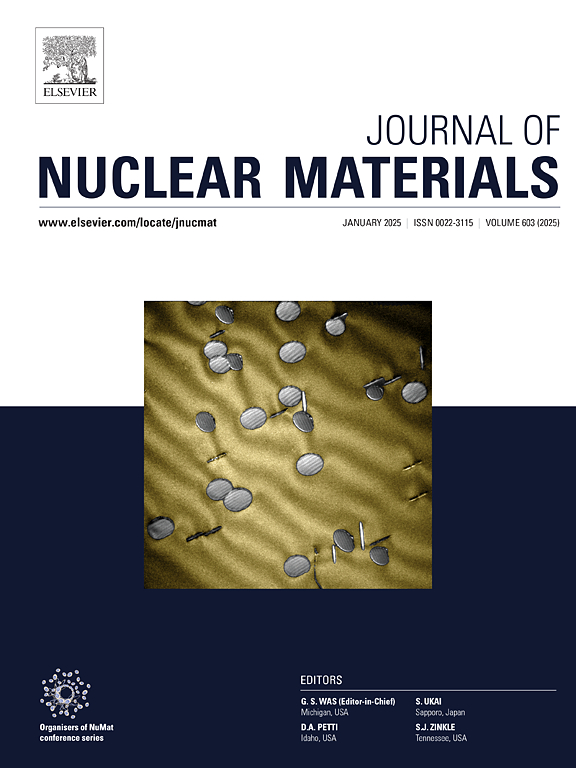TEM characterization of two variants of fuel cladding chemical interaction in a HT-9 Clad U-10Zr Fuel. Variant 1: FCCI with a Zr Rind
IF 2.8
2区 工程技术
Q3 MATERIALS SCIENCE, MULTIDISCIPLINARY
引用次数: 0
Abstract
This study investigated the fuel cladding chemical interaction (FCCI), a key factor that limits operational temperature and burnup, in an HT-9 clad U-10Zr nuclear fuel sample irradiated to a high burnup of 13.1 at.% at a time-averaged peak inner cladding temperature (PICT) of 530 °C. Previous results showed this fuel sample exhibited two distinct levels of FCCI at d. This paper analyzed the FCCI at an azimuthal position showing an interdiffusion layer of <10 µm using transmission electron microscopy to examine chemical and crystallographic nature of phases at the fuel-cladding interface at the nanoscale level. A ZrC layer and a Zr3Si phase were identified at the interface; these, along with the relatively low local temperature, potentially contributed to limit interdiffusion, behaving as inhibitors for deleterious interactions. Lanthanides (Ln) partially consumed the ZrC layer and interacted with Fe, forming a Zr-Ln compound and a (Zr,Ce)Fe2+x phase while also infiltrating up to 4 µm into the cladding. Neither U nor Zr were observed in the cladding, whereas Fe diffused up to 3–5 µm in the fuel. Fe infiltration formed a ternary U-Zr-Fe ε-phase and likely promoted the precipitation of a Cr-rich α’ phase on the cladding interface. Additionally, a Cr-rich χ-phase, likely formed by the dissociation of pre-existing M23C6 carbide precipitates, was identified about 2–5 µm from the fuel-cladding interface. Irradiation-induced nano-voids were also observed in the HT-9 bulk. These findings provide critical insights into FCCI mechanisms at representative irradiation conditions, essential for developing models simulating in-pile metallic fuel behaviors for next-generation reactors.
HT-9包覆U-10Zr燃料包壳化学相互作用的两种变体的TEM表征。变体1:带有Zr环的FCCI
本研究对辐照至高燃耗13.1 at的HT-9包层U-10Zr核燃料样品的燃料包层化学相互作用(FCCI)进行了研究,FCCI是限制操作温度和燃耗的关键因素。%,时间平均峰值内包层温度(PICT)为530℃。先前的结果表明,该燃料样品在d处表现出两种不同水平的FCCI。本文在方位角处分析了FCCI,显示了<;10 μ m的互扩散层,使用透射电子显微镜在纳米尺度上检查了燃料包层界面处相的化学和晶体性质。在界面处发现了ZrC层和Zr3Si相;这些因素,加上相对较低的当地温度,可能会限制相互扩散,起到抑制有害相互作用的作用。镧系元素(Ln)部分消耗了ZrC层,并与Fe相互作用,形成了Zr-Ln化合物和(Zr,Ce)Fe2+x相,同时也渗透到包层中高达4µm。包层中未观察到U和Zr,而Fe在燃料中扩散至3-5µm。Fe的渗入形成了U-Zr-Fe的ε-三元相,可能促进了包层界面上富cr α′相的析出。此外,在距燃料包层界面约2-5 μ m处发现了富cr的χ-相,可能是由先前存在的M23C6碳化物析出相解离形成的。在HT-9体中也观察到辐照诱导的纳米空洞。这些发现为典型辐照条件下的FCCI机制提供了重要见解,对于开发模拟下一代反应堆堆内金属燃料行为的模型至关重要。
本文章由计算机程序翻译,如有差异,请以英文原文为准。
求助全文
约1分钟内获得全文
求助全文
来源期刊

Journal of Nuclear Materials
工程技术-材料科学:综合
CiteScore
5.70
自引率
25.80%
发文量
601
审稿时长
63 days
期刊介绍:
The Journal of Nuclear Materials publishes high quality papers in materials research for nuclear applications, primarily fission reactors, fusion reactors, and similar environments including radiation areas of charged particle accelerators. Both original research and critical review papers covering experimental, theoretical, and computational aspects of either fundamental or applied nature are welcome.
The breadth of the field is such that a wide range of processes and properties in the field of materials science and engineering is of interest to the readership, spanning atom-scale processes, microstructures, thermodynamics, mechanical properties, physical properties, and corrosion, for example.
Topics covered by JNM
Fission reactor materials, including fuels, cladding, core structures, pressure vessels, coolant interactions with materials, moderator and control components, fission product behavior.
Materials aspects of the entire fuel cycle.
Materials aspects of the actinides and their compounds.
Performance of nuclear waste materials; materials aspects of the immobilization of wastes.
Fusion reactor materials, including first walls, blankets, insulators and magnets.
Neutron and charged particle radiation effects in materials, including defects, transmutations, microstructures, phase changes and macroscopic properties.
Interaction of plasmas, ion beams, electron beams and electromagnetic radiation with materials relevant to nuclear systems.
 求助内容:
求助内容: 应助结果提醒方式:
应助结果提醒方式:


